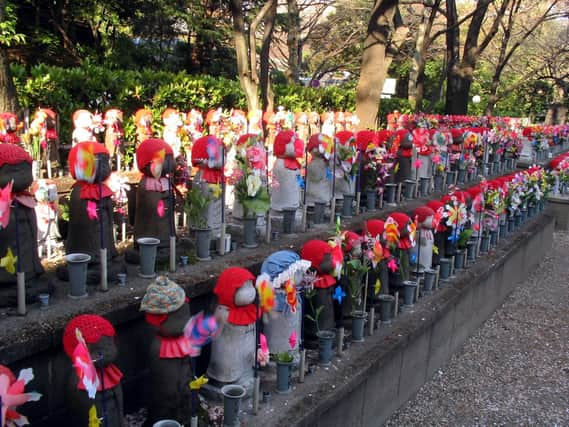The lasting effects of loss, trauma, and longing need a pressure valve – Laura Waddell


Once, over a decade ago, I had the good fortune to visit Tokyo, and one humid night, walking the grassy periphery of the Zozoji Temple grounds, red and white lights of Tokyo Tower looming in haze overhead, my travel companion and I came across what looked like lots of small dolls placed in rows.
They turned out to be stone statues of infants, no taller than a foot high, lined up and standing to attention, many wearing homemade red knitted caps and bibs. Placed nearby were plastic flowers and paper windmills which spun in the breeze, a small, high-pitched whirring which somehow managed to break through the incessant shriek of invisible cicadas and the anonymous din of the megacity, cushioned a little by the few blocks of park.
Advertisement
Hide AdAdvertisement
Hide AdTo encounter the memorial unexpectedly after dark was eerie, all those small faces confronting their observer at once.
Later, I discovered this is known as the Garden of Unborn Children, and the statues were mizuko kuyō dolls, ceremonial memorials for children lost before birth, such as to miscarriage.
The dolls are made in the form of Jizō, Buddhist protector of women and children, thought able to guide souls through the afterlife. Some have criticised the costs involved but the practice, it is believed, offers a form of closure to those who have suffered loss; the dolls, a tangible object on which to focus unresolved hopes.
In the recent novel, The Pachinko Parlour by Elisa Shua Dusapin, translated from French by Aneesa Abbas Higgins, Mieko is the young ward of late-20s language tutor Claire, who has picked up teaching work over a long, restless summer visiting her Korean grandparents in Tokyo.
They own the gaming establishment of the title; called Shiny, its bright lights illuminating an otherwise tired street, it can be seen from the vantage point of their claustrophobic apartment.
“We used to come for two or three weeks a year… I remember the players smelling of grilled meat, cigarettes. How cold it was in the winter when the doors swung open. They piped music. The silent players, deep in concentration, sweating.” Her grandfather, in lieu of a pension, continues to work long into his old age; her grandmother is home alone most days.
Pupil Mieko is an introverted, headstrong child with a distant, busy single mother; together they live in a converted hotel of odd proportions, the kid’s bedroom – improbably – a never-used swimming pool pit fitted with a bed and chest of drawers.
Delighted to discover her tutor’s 30th birthday falls on a teaching day, Mieko presents Claire with dolls made of bamboo sticks, golf balls, Sellotape and seaweed for hair. Her mother immediately apologises for an inappropriate gift.
Advertisement
Hide AdAdvertisement
Hide Ad“They’re kokeshi dolls… people used to make them to remember the babies they killed because they couldn’t feed them. Mieko knows perfectly well. I’m very sorry.” Now attached to her ward, Claire keeps them anyway.
Reminiscent of the novellas of Elena Ferrante, Dusapin’s book excels at subtle moments of familial psychodrama between mothers and daughters, granddaughters and grandmothers, and teacher and pupil.
No matter how tightly packed down inside, without a pressure valve the lasting effects of loss, trauma, and longing can interplay through generations.
Comments
Want to join the conversation? Please or to comment on this article.

